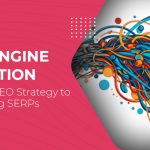The fast-changing environment in the digital world has made web design more than just aesthetics and coding. It is an interdisciplinary activity today, which combines creativity, functionality and data science. The core of this change is Artificial Intelligence (AI), a game-changer that is changing the way websites are thought, created, and lived. The AI concept is no longer something that is a distant future; it is a current requirement that can increase efficiency, personalize the experience and open new horizons of creative possibilities.
Automated code generation, real-time user insights, and AI-assisted web design are just some of the ways in which AI is making the web design process more efficient and establishing new benchmarks of user engagement. This blog will discuss the ways in which artificial intelligence is transforming web design, both in front-end visual appearance and back-end structure and tests, combining the perspectives of two of the most prominent sources into a cohesive and futuristic story.
AI and Web Design: A New Paradigm
Conventionally, web design was painstaking, careful coding, and testing. All the elements, including layouts and navigation, content and performance required manual implementation. Although this was effective, it was time-consuming and in many cases restricted by human error.
When combined with machine learning (ML), natural language processing (NLP), data analytics, and automation, AI makes the previously static web processes dynamic ecosystems. It enables designers and developers to automate repetitive work, create intelligent content, optimize interfaces and offer real-time customization.
The development has been catalyzed by the fact that AI has the capacity to:
- Process large amounts of data in real-time – so that systems can analyze user interactions, traffic patterns and operational metrics to make more intelligent design and performance decisions.
- Find patterns in behavior detailing the way various users navigate, click, and interact assists in customizing experiences to fit the preferences of the individual.
Create responsive layouts
How content is organized on the page can be automatically adjusted depending on type of device, geographical location or in real time to maximize engagement.
Make content delivery personalized
Deliver personalised messages, products or layouts to users to enhance better satisfaction and conversion rates.
Automate coding and debugging
Less manual programming by creating boilerplate code, proposing solutions, or warning about possible bugs before they become major issues.
Implement better SEO practices
Automatic optimization of page structures, keywords, and metadata according to real-time trends in algorithms.
Anticipate user behaviour to enhance UX
Machine learning can be used to predict user requirements so that you can make improvements to your design before it is required, and create more natural interfaces.
This has made AI an essential and inseparable part of any serious web development team, agency, or platform that wants to remain competitive in a user-centered digital environment.
The AI Revolutionized Front-End Design
The most noticeable advantage of AI-powered tools is in the front-end of a site, or the side that users see and interact with.
A. Design Automation and Smart Prototyping
Platforms such as Wix ADI, Adobe Sensei, and Uizard use AI to create entire design mockups according to user input, wireframes or even sketches. AI can read design intentions and in a matter of seconds, it can generate interfaces that are visually appealing, eliminating the extended design cycles.
As an example, the Taobao squad of Alibaba applied AI to turn 90 percent of their wireframes into functioning code, at an efficiency rate of 68 percent. Other tools such as Sketch2Code and Bubble are also innovative in this area, enabling designers to bypass lengthy processes and tackle more innovation.
B. AI-based UX/UI Personalized Tools
They analyze past user activity and live interactions, and personalize the content of the websites dynamically. This means:
Online shopping websites with product suggestions Personalised product suggestions on e-commerce websites – showing relevant products based on browsing history and purchase patterns, which improves the likelihood of conversion.
- Personalised landing pages according to location or previous activity – offering location-specific content, deals or imagery that appeals to local users.
- Adaptive navigation systems – restructuring menus or emphasizing particular features depending on what the AI knows about the user preferences and previous site visits.
C. Performance Optimization AI models
They can be trained to detect performance bottlenecks, including unoptimized images, too many scripts, or duplicate CSS. These systems are able to scan and propose (or apply) improvements that can radically improve page loads.
D. Smart interaction Design
AI-based chatbots (with NLP and voice recognition) provide immediate human-like assistance. Through studying the most frequent questions, these bots learn to respond quicker and more correctly, thus increasing customer satisfaction and relieving the human support personnel.
AI-Enhanced Back-End Functionality
Under the hood, AI is essential in making server-side development, debugging, security, and data management more efficient.
A. Code Generation and Assistance AI
Models such as OpenAI Codex, GitHub Copilot, and ChatGPT have the ability to automatically generate lines of code, suggest logic optimizations, and even create fully functional modules. Although human supervision is still necessary, these tools make the development process much shorter and minimize errors.
B. Bug Detection and Resolution
There are thousands of lines of code to go through, and manual debugging is not scalable. CodePal and Microsoft Code Defect AI AI tools can:
- Instant bug detection with a glance: read through huge codebases in a matter of seconds, to find the inconsistencies, syntax errors, or possible bugs.
Determining the line or function of the fault (where the bugs are located) to save the developers time and make error tracing less complex.
- Proposing remedial code: It provides smart suggestions on how to fix the code based on contextual knowledge of the code logic surrounding it.
C. Security and Threat Management
AI algorithms can track the traffic at the site, the activity of the users, and the logins in real-time. Such tools as Vectra AI identify anomalies which indicate possible security breaches. After being flagged, these tools may alert admins or even implement pre-set safety measures.
D. Data Analysis and Decision-Making
AI-based tools such as AI2SQL enables web developers and marketers to extract actionable insights about user data. To:
- Segment audiences: separating users into different segments according to demographics, behavior or purchasing patterns, which allows more specific marketing and communication.
- Personalize UX: modifying features, layouts, or content of the site to suit individual profiles of users in order to make it more relevant and satisfying.
- Improve guide design using data trends: which elements are performing better, which layouts are converting higher, where users drop off, so that design choices are supported by real time data.
AI in QA Testing: Speed and Accuracy in One
The last but not the least step in web development is testing. Here, AI has brought game-changing efficiencies too.
Testing tools such as Testim, Katalon, and Applitools can perform several tests at once and examine the UI/UX actions. These platforms:
- Run automated test scripts: They enable fast, repeatable testing cycles that are broad in use case coverage with no manual intervention required.
- Spot visual and functional inconsistency: They detect layout changes, broken components, or misplaced elements that may negatively affect user experience.
- Detect responsiveness problems across devices: This makes sure that websites are equally functional and look on desktops, tablets, and smartphones.
- Anticipate failure zones prior to deployment: They use historical test data and current configurations, predict possible bugs or crashes to proactively resolve the problem.
Using AI in the QA stage, companies minimize the number of errors that appear after the release, enhance the user experience, and maximize the load.
AI in Content Creation and SEO
The king is content, but only when it is optimized in terms of search and user intent. AI is increasingly playing a significant role in content planning and implementation.
A. Content Generation Tools such as ChatGPT and Jasper AI help in:
- Writing blogs, product descriptions, and web copy
- Brand tone consistency across platforms
- Writing A/B tested variations
B. SEO Optimization Using such tools as SurferSEO, companies can:
- Examine keyword density
- Write content in a readable format and searchable content
- Competitor benchmarking
- Optimize the headings, metadata and semantic keywords
C. Visual Content Design Graphic AI tools like Canva AI and Adobe Sensei assist in automating design choices:
- Image resizing
- Recommendations on color scheme
- The pairing of fonts and logo changes
Visual asset creation is accelerated by such tools and also helps to maintain brand consistency across devices.
Real-Time User Behavior Analysis
AI makes it possible to analyze the behavior of your users in real time. Such tools as Hotjar AI and Google Analytics (GA4) offer:
Heatmaps and Click Tracking
The visualization of where users click, scroll, and linger most, is used to define areas of high engagement and low performance.
Session Recordings
A recording of real user sessions to monitor behavior, debug, and enhance navigation.
Conversion Funnel Analysis
The process of measuring the journey a user takes through a sales or signup process to identify where users drop off and improve conversion tactics.
Predictive Behavior Modeling
Forecasting future behavior based on past data and machine learning, so teams can take timely action with personalized content or design modifications.
Based on this data, designers and marketers can:
- Restructure page layouts – reorganizing the visuals and content structure according to engagement data so as to bring out what is of utmost interest to users.
- Enhance CTAs – making the call-to-action buttons more effective in terms of placement, wording, and color in order to boost their click-through rates and user responsiveness.
- Optimize the user experience pathway – isolate and eliminate points of friction within the navigation path to streamline the experience and make it more natural.
- Make future visits personalized – site content, layout, and messaging is customized to returning users based on the behavior and preferences in the past to increase engagement and loyalty.
The Place of Agencies such as Digital Gravity KSA in AI-Driven Design
Digital Gravity KSA is one of the web design agencies that illustrates how human creativity and AI-powered technology can be combined to create high-performing websites. Digital Gravity KSA boosts:
- Speed of project turnaround
- Content precision
- Aesthetic innovation
- Conversion rates
They combine the following approach:
- AI-assisted prototyping
- Evidence-based management
- Combined SEO and content-based approaches
- User experience testing in real time
Digital Gravity KSA does not only make websites, but they create smart, dynamic and scalable digital ecosystems.
The Future: How AI will Continue to Dominate Web Design
It is estimated that the AI market will exceed 126 billion dollars by 2025. AI technologies will continue to develop, and their accessibility will increase, bringing web design to the next level.
This is what we can look forward to:
- Prompt or sketch to full-site generation
- Behavioral AI-powered hyper-personalized UX
- Flawless interoperability with robotics, IoT, and big data
- Improving accessibility through real-time design and language changes
- Increased use of AI in compliance, security, and ethical design
However, it is important to mention: AI will not substitute designers and developers, it will enable them. The creativity, instinct, and expertise that professionals possess cannot be replaced by algorithms. AI merely clears the way to more significant and meaningful creativity.
Conclusion
The combination of artificial intelligence and web design is no longer a speculation, it is the foundation of the current digital experience. AI is changing every aspect of web development, including front-end automation and personalized UX, back-end security, and SEO optimization. However, the real strength is not in automation, but in augmentation, as AI can assist creative professionals in doing more, doing it better, and doing it faster.
Web design companies that adopt AI in web development will be in a better position as they will be able to provide more intelligent, quicker, and more interactive online experiences. With the further development of AI, the demands of the users will only grow, and the possibilities of the designers who will not be afraid of using its potential will increase.







